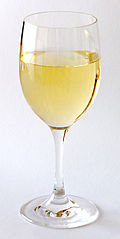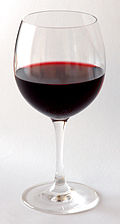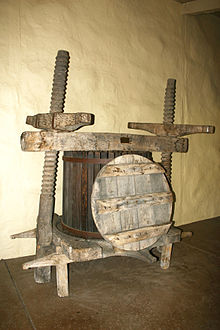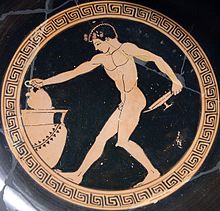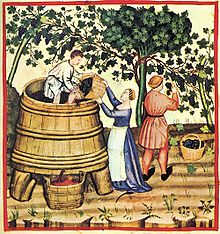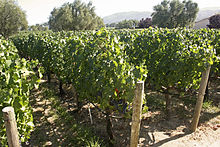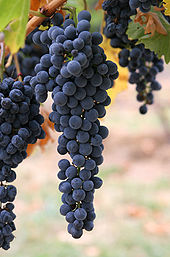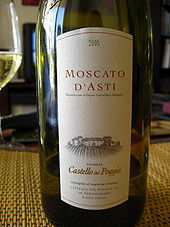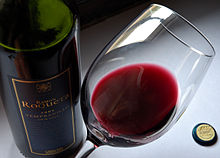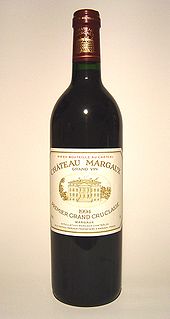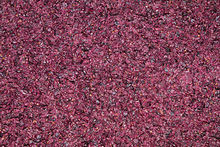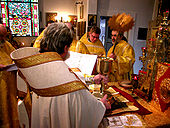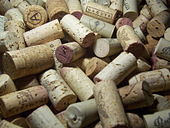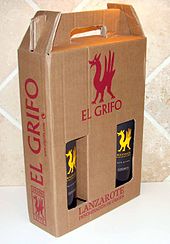
Wine
About this schools Wikipedia selection
SOS believes education gives a better chance in life to children in the developing world too. Click here for more information on SOS Children.
Wine is an alcoholic beverage made from fermented grapes or other fruits. The natural chemical balance of grapes lets them ferment without the addition of sugars, acids, enzymes, water, or other nutrients. Yeast consumes the sugars in the grapes and converts them into alcohol. Different varieties of grapes and strains of yeasts produce different types of wine. The well-known variations result from the very complex interactions between the biochemical development of the fruit, reactions involved in fermentation, and human intervention in the overall process. The final product may contain tens of thousands of chemical compounds in amounts varying from a few percent to a few parts per billion.
Wines made from fruits besides grapes are usually named after the fruit from which they are produced (for example, pomegranate wine, apple wine and elderberry wine) and are generically called fruit wine. The term "wine" can also refer to starch-fermented or fortified beverages having higher alcohol content, such as barley wine or sake.
Wine has a rich history dating back thousands of years, with the earliest known production occurring around 6000 BC in Georgia. It first appeared in the Balkans about 4500 BC and was very common in ancient Greece, Thrace and Rome. Wine has also played an important role in religion throughout history. The Greek god Dionysus and the Roman equivalent, Bacchus, represented wine. The drink is also used in Christian Eucharist ceremonies and the Jewish Kiddush.
Etymology
The English word "wine" comes from the Proto-Germanic *winam, an early borrowing from the Latin vinum, "wine" or "(grape) vine", itself derived from the Proto-Indo-European stem *win-o- (cf. Hittite: wiyana; Lycian: oino; Ancient Greek: οἶνος oinos; Aeolic Greek: ϝοῖνος woinos).
The earliest attested terms referring to wine are the Mycenaean Greek me-tu-wo ne-wo (μέθυος νέου), meaning "the month of new wine" or "festival of the new wine", and wo-no-wa-ti-si, meaning "wine garden", written in Linear B inscriptions.
Some scholars have noted the similarities between the words for wine in Kartvelian (e.g. Georgian ღვინო [ɣvinɔ]), Indo-European languages (e.g. Russian вино [vino]), and Semitic (*wayn), pointing to the possibility of a common origin of the word denoting "wine" in these language families. Some scholars have argued that Georgian was the origin of this word and that it entered into the Indo-European languages via Semitic. The proponents of this view have argued that in Kartvelian languages the semantic connection of the word "wine" (ღვინო - ghvino, ღვინი - ghvini, ღვინალ - ghvinal) is traced to the verb "ghvivili" (ღვივილი, to bloom, to arouse, to boil, to ferment) and the root of "ghv" (ღვ), which is a common semantic root for many common Kartvelian words (e.g. "gaghvidzeba", გაღვიძება - to awaken, "ghvidzli" - ღვიძლი - liver).
Wines from other fruits, such as apples and berries, are usually named after the fruit from which they are produced combined with the word "wine" (for example, apple wine and elderberry wine) and are generically called fruit wine or country wine (not to be confused with the French term vin de pays). Besides the grape varieties traditionally used for winemaking, most fruits naturally lack either a high amount of fermentable sugars, relatively low acidity, yeast nutrients needed to promote or maintain fermentation or a combination of these three characteristics. This is probably one of the main reasons why wine derived from grapes has historically been more prevalent by far than other types and why specific types of fruit wine have generally been confined to regions in which the fruits were native or introduced for other reasons.
Other wines, such as barley wine and rice wine (e.g. sake), are made from starch-based materials and resemble beer more than wine, while ginger wine is fortified with brandy. In these latter cases, the term "wine" refers to the similarity in alcohol content rather than to the production process. The commercial use of the English word "wine" (and its equivalent in other languages) is protected by law in many jurisdictions.
History
Archaeological evidence suggests that the earliest known production of wine, made by fermenting grapes, took place from the late Neolithic or early Chalcolithic, possibly as early as the sixth millennium BC, between the Caucasus and the Middle East, with evidence of winemaking at different sites dated from 6000 BC in Georgia, 5000 BC in Iran, and 4100 BC in Armenia. During an extensive gene-mapping project in 2006, archaeologists analyzed the heritage of more than 110 modern grape cultivars, narrowing their origin to a region in Georgia, where wine residues were also discovered on the inner surfaces of 8,000-year-old ceramic storage jars. Chemical analysis of 7,000-year-old pottery shards indicated early winemaking in the Neolithic village of Hajji Firuz Tepe in Iran's Zagros Mountains. Other notable areas of wine production have been discovered in Greece and date back to 4500 BC. The same sites also contain the world's earliest evidence of crushed grapes. A winemaking press found in 2011 in the Areni-1 site of Armenia has been dated to around 4100 BC.
However, the spread of wine culture westwards was most probably due to the Phoenicians who were centered on the coastal strip of today’s Lebanon – itself one of the world’s oldest sites of wine production. The wines of Byblos were exported to Egypt during the Old Kingdom (2686 BC–2134 BC) and throughout the Mediterranean. Evidences include two Phoenician shipwrecks from 750 BC discovered by Robert Ballard, whose cargo of wine was still intact. As the first great traders of wine ('Cherem'), the Phoenicians seem to have protected it from oxidation with a layer of olive oil, followed by a seal of pinewood and resin - this may well be the origin of the Greek retsina.
Literary references to wine are abundant in Homer (8th century BC, but possibly composed even earlier), Alkman (7th century BC), and others. In ancient Egypt, six of 36 wine amphoras were found in the tomb of King Tutankhamun bearing the name "Kha'y", a royal chief vintner. Five of these amphoras were designated as originating from the king's personal estate, with the sixth from the estate of the royal house of Aten. Traces of wine have also been found in central Asian Xinjiang in modern-day China, dating from the second and first millennia BC.
The first known mention of grape-based wines in India is from the late 4th-century BC writings of Chanakya, the chief minister of Emperor Chandragupta Maurya. In his writings, Chanakya condemns the use of alcohol while chronicling the emperor and his court's frequent indulgence of a style of wine known as madhu.
A 2003 report by archaeologists indicates a possibility that grapes were mixed with rice to produce mixed fermented beverages in China in the early years of the seventh millennium BC. Pottery jars from the Neolithic site of Jiahu, Henan, contained traces of tartaric acid and other organic compounds commonly found in wine. However, other fruits indigenous to the region, such as hawthorn, cannot be ruled out. If these beverages, which seem to be the precursors of rice wine, included grapes rather than other fruits, they would have been any of the several dozen indigenous wild species in China, rather than Vitis vinifera, which was introduced there some 6,000 years later.
One of the lasting legacies of the ancient Roman Empire was the viticultural foundation laid by the Romans in the areas that today are world-renowned wine regions. In places with garrison towns (e.g. Bordeaux, Trier, and Colchester), the Romans planted vineyards to supply local needs and limit the cost of long-distance trading. In medieval Europe, the Roman Catholic Church supported wine because the clergy required it for the Mass. Monks in France made wine for years, aging it in caves. An old English recipe that survived in various forms until the 19th century calls for refining white wine from bastard—bad or tainted bastardo wine.
Grape varieties
Wine is usually made from one or more varieties of the European species Vitis vinifera, such as Pinot Noir, Chardonnay, Cabernet Sauvignon, Gamay and Merlot. When one of these varieties is used as the predominant grape (usually defined by law as minimums of 75% to 85%), the result is a " varietal" as opposed to a "blended" wine. Blended wines are not considered inferior to varietal wines, rather they are a different style of winemaking; some of the world's most highly regarded wines, from regions like Bordeaux and the Rhone Valley, are blended from different grape varieties.
Wine can also be made from other species of grape or from hybrids, created by the genetic crossing of two species. V. labrusca (of which the Concord grape is a cultivar), V. aestivalis, V. ruprestris, V. rotundifolia and V. riparia are native North American grapes usually grown to eat fresh or for grape juice, jam, or jelly, and only occasionally made into wine.
Hybridization is different from grafting. Most of the world's vineyards are planted with European V. vinifera vines that have been grafted onto North American species' rootstock, a common practice due to their resistance to phylloxera, a root louse that eventually kills the vine. In the late 19th century, most of Europe's vineyards (excluding some of the driest in the south) were devastated by the infestation, leading to widespread vine deaths and eventual replanting. Grafting is done in every wine-producing region in the world except in Argentina, the Canary Islands and Chile—the only places not yet exposed to the insect.
In the context of wine production, terroir is a concept that encompasses the varieties of grapes used, elevation and shape of the vineyard, type and chemistry of soil, climate and seasonal conditions, and the local yeast cultures. The range of possible combinations of these factors can result in great differences among wines, influencing the fermentation, finishing, and aging processes as well. Many wineries use growing and production methods that preserve or accentuate the aroma and taste influences of their unique terroir. However, flavor differences are less desirable for producers of mass-market table wine or other cheaper wines, where consistency takes precedence. Such producers try to minimize differences in sources of grapes through production techniques such as micro-oxygenation, tannin filtration, cross-flow filtration, thin-film evaporation, and spinning cones.
Classification
Regulations govern the classification and sale of wine in many regions of the world. European wines tend to be classified by region (e.g. Bordeaux, Rioja and Chianti), while non-European wines are most often classified by grape (e.g. Pinot Noir and Merlot). Market recognition of particular regions has recently been leading to their increased prominence on non-European wine labels. Examples of recognized non-European locales include Napa Valley and Sonoma Valley in California; Willamette Valley in Oregon; Columbia Valley in Washington; Barossa Valley in South Australia and Hunter Valley in New South Wales; Luján de Cuyo in Argentina; Central Valley in Chile; Vale dos Vinhedos in Brazil; Hawke's Bay and Marlborough in New Zealand; and Okanagan Valley and Niagara Peninsula in Canada.
Some blended wine names are marketing terms whose use is governed by trademark law rather than by specific wine laws. For example, Meritage (sounds like "heritage") is generally a Bordeaux-style blend of Cabernet Sauvignon and Merlot, but may also include Cabernet Franc, Petit Verdot, and Malbec. Commercial use of the term Meritage is allowed only via licensing agreements with the Meritage Association.
European classifications
France has various appellation systems based on the concept of terroir, with classifications ranging from Vin de Table ("table wine") at the bottom, through Vin de Pays and Appellation d'Origine Vin Délimité de Qualité Supérieure (AOVDQS), up to Appellation d'Origine Contrôlée (AOC) or similar, depending on the region. Portugal has developed a system resembling that of France and, in fact, pioneered this concept in 1756 with a royal charter creating the Demarcated Douro Region and regulating the production and trade of wine. Germany created a similar scheme in 2002, although it has not yet achieved the authority of the other countries' classification systems. Spain, Greece and Italy have classifications based on a dual system of region of origin and product quality.
Beyond Europe
New World wines—those made outside the traditional wine regions of Europe—are usually classified by grape rather than by terroir or region of origin, although there have been unofficial attempts to classify them by quality.
Vintages
A "vintage wine" is made from grapes that were all or mostly grown in a particular year, and labeled as such. Some countries allow a vintage wine to include a small portion that is not from the labeled vintage. Variations in a wine's character from year to year can include subtle differences in colour, palate, nose, body and development. High-quality wines can improve in flavor with age if properly stored. Consequently, it is not uncommon for wine enthusiasts and traders to save bottles of an especially good vintage wine for future consumption.
In the United States, for a wine to be vintage-dated and labeled with a country of origin or American Viticultural Area (AVA) (e.g. Sonoma Valley), 95% of its volume must be from grapes harvested in that year. If a wine is not labeled with a country of origin or AVA the percentage requirement is lowered to 85%.
Vintage wines are generally bottled in a single batch so that each bottle will have a similar taste. Climate's impact on the character of a wine can be significant enough to cause different vintages from the same vineyard to vary dramatically in flavor and quality. Thus, vintage wines are produced to be individually characteristic of the particular vintage and to serve as the flagship wines of the producer. Superior vintages from reputable producers and regions will often command much higher prices than their average ones. Some vintage wines (e.g. Brunello), are only made in better-than-average years.
For consistency, non-vintage wines can be blended from more than one vintage, which helps winemakers sustain a reliable market image and maintain sales even in bad years. One recent study suggests that for the average wine drinker, the vintage year may not be as significant for perceived quality as had been thought, although wine connoisseurs continue to place great importance on it.
Tasting
Wine tasting is the sensory examination and evaluation of wine. Wines contain many chemical compounds similar or identical to those in fruits, vegetables, and spices. The sweetness of wine is determined by the amount of residual sugar in the wine after fermentation, relative to the acidity present in the wine. Dry wine, for example, has only a small amount of residual sugar.
Some wine labels suggest opening the bottle and letting the wine "breathe" for a couple of hours before serving, while others recommend drinking it immediately. Decanting (the act of pouring a wine into a special container just for breathing) is a controversial subject among wine enthusiasts. In addition to aeration, decanting with a filter allows the removal of bitter sediments that may have formed in the wine. Sediment is more common in older bottles, but aeration may benefit younger wines.
During aeration, a younger wine's exposure to air often "relaxes" the drink, making it smoother and better integrated in aroma, texture, and flavor. Older wines generally "fade" (lose their character and flavor intensity) with extended aeration. Despite these general rules, breathing does not necessarily benefit all wines. Wine may be tasted as soon as the bottle is opened to determine how long it should be aerated, if at all.
When tasting wine, individual flavours may also be detected, due to the complex mix of organic molecules (e.g. esters and terpenes) that grape juice and wine can contain. Experienced tasters can distinguish between flavors characteristic of a specific grape and flavours that result from other factors in winemaking. Typical intentional flavor elements in wine—chocolate, vanilla, or coffee—are those imparted by aging in oak casks rather than the grape itself.
Banana flavours ( isoamyl acetate) are the product of yeast metabolism, as are spoilage aromas such as sweaty, barnyard, band-aid ( 4-ethylphenol and 4-ethylguaiacol), and rotten egg ( hydrogen sulfide). Some varietals can also exhibit a mineral flavor due to the presence of water-soluble salts as a result of limestone's presence in the vineyard's soil.
Wine aroma comes from volatile compounds released into the air. Vaporization of these compounds can be accelerated by twirling the wine glass or serving at room temperature. Many drinkers prefer to chill red wines that are already highly aromatic, like Chinon and Beaujolais.
The ideal temperature for serving a particular wine is a matter of debate, but some broad guidelines have emerged that will generally enhance the experience of tasting certain common wines. A white wine should foster a sense of coolness, achieved by serving at "cellar temperature" (55°F/13°C). Light red wines drunk young should also be brought to the table at this temperature, where they will quickly rise a few degrees. Red wines are generally perceived best when served chambré ("at room temperature"). However, this does not mean the temperature of the dining room—often around 70°F/21°C—but rather the coolest room in the house and, therefore, always slightly cooler than the dining room itself. Pinot Noir should be brought to the table for serving at 60°F/16°C and will reach its full bouquet at 65°F/18°C. Cabernet Sauvignon, zinfandel, and Rhone varieties should be served at 65°F/18°C and allowed to warm on the table to 70°F/21°C for best aroma.
Collecting
Outstanding vintages from the best vineyards may sell for thousands of dollars per bottle, though the broader term "fine wine" covers those typically retailing in excess of US$30–50. " Investment wines" are considered by some to be Veblen goods: those for which demand increases rather than decreases as their prices rise. The most common wines purchased for investment include those from Bordeaux and Burgundy; cult wines from Europe and elsewhere; and vintage port. Characteristics of highly collectible wines include:
- A proven track record of holding well over time
- A drinking-window plateau (i.e., the period for maturity and approachability) that is many years long
- A consensus among experts as to the quality of the wines
- Rigorous production methods at every stage, including grape selection and appropriate barrel aging
Investment in fine wine has attracted those who take advantage of their victims' relative ignorance of this wine market sector. Such wine fraudsters often profit by charging excessively high prices for off-vintage or lower-status wines from well-known wine regions, while claiming that they are offering a sound investment unaffected by economic cycles. As with any investment, thorough research is essential to making an informed decision.
Production
* FAO estimate. |
* FAO estimate. |
Wine grapes grow almost exclusively between 30 and 50 degrees latitude north and south of the equator. The world's southernmost vineyards are in the Central Otago region of New Zealand's South Island near the 45th parallel south, and the northernmost are in Flen, Sweden, just north of the 59th parallel north.
Exporting countries
The UK was the world's largest importer of wine in 2007.
Wine production in the European Union in 2005 and 2006
2006 Estimate (thousands of hectolitres)
2005 Estimate (thousands of hectolitres)
World production in 2003
In 2003, world wine production had reached 269 millions of hectolitres. The world's main 15 wine producers were:
| Country | millions of hectolitres |
|---|---|
| France | 47.3 |
| Italy | 46.8 |
| Spain | 39.5 |
| USA | 23.5 |
| Australia | 12.6 |
| Argentina | 12.2 |
| China | 10.8 |
| Germany | 10.2 |
| South Africa | 7.6 |
| Portugal | 6.8 |
| Chile | 5.8 |
| Romania | 5.5 |
| Greece | 4.2 |
| Russia | 4.1 |
| Hungary | 4.0 |
The world's 10 main wine exporting countries in 2005
| Country | thousands of hectolitres |
|---|---|
| Italy | 15,100 |
| Spain | 14,439 |
| France | 13,900 |
| Australia | 7,019 |
| Chile | 4,209 |
| USA | 3,482 |
| Germany | 2,970 |
| South Africa | 2,818 |
| Portugal | 2,800 |
| Moldova | 2,425 |
| TOTAL | 78,729 |
Consumption
Wine-consumption data from a list of countries by alcohol consumption measured in liters of pure ethyl alcohol consumed per capita in a given year, according to the most recent data from the World Health Organization. The methodology includes persons 15 years of age or older.
|
|
Uses
Wine is a popular and important beverage that accompanies and enhances a wide range of European- and Mediterranean-style cuisines, from the simple and traditional to the most sophisticated and complex. Wine is important in cuisine not just for its value as a beverage, but as a flavor agent, primarily in stocks and braising, since its acidity lends balance to rich savory or sweet dishes. Red, white, and sparkling wines are the most popular styles of wine, and are known as "light wines" because they are only 10–14% alcohol by volume. Apéritif and dessert wines contain 14–20% alcohol, some of which have been fortified (e.g. with brandy) to make them richer and sweeter.
Religious significance
Ancient religions
The use of wine in religious ceremonies is common to many cultures and regions. Libations often included wine, and the religious mysteries of Dionysus used wine as a sacramental entheogen to induce a mind-altering state.
Judaism
Wine is an integral part of Jewish laws and traditions. The Kiddush is a blessing recited over wine or grape juice to sanctify the Shabbat. On Pesach ( Passover) during the Seder, it is a Rabbinic obligation of adults to drink four cups of wine. In the Tabernacle and in the Temple in Jerusalem, the libation of wine was part of the sacrificial service. Note that this does not mean that wine is a symbol of blood, a common misconception that contributes to the myth of the blood libel. The blessing over wine said before consuming the drink is: "Baruch atah Hashem (Adonai) Eloheinu melech ha-olam, boray p’ree hagafen"—"Praised be the Lord, our God, King of the universe, Creator of the fruit of the vine."
Christianity
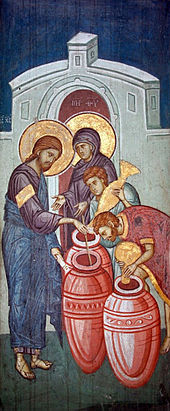
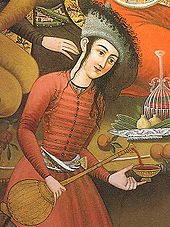
In Christianity, wine is used in a sacred rite called the Eucharist, which originates in the Gospel account of the Last Supper ( Gospel of Luke 22:19) describing Jesus sharing bread and wine with his disciples and commanding them to "do this in remembrance of me." Beliefs about the nature of the Eucharist vary among denominations (see Eucharistic theologies contrasted).
While some Christians consider the use of wine from the grape as essential for the validity of the sacrament, many Protestants also allow (or require) pasteurized grape juice as a substitute. Wine was used in Eucharistic rites by all Protestant groups until an alternative arose in the late 19th century. Methodist dentist and prohibitionist Thomas Bramwell Welch applied new pasteurization techniques to stop the natural fermentation process of grape juice. Some Christians who were part of the growing temperance movement pressed for a switch from wine to grape juice, and the substitution spread quickly over much of the United States, as well as to other countries to a lesser degree. There remains an ongoing debate between some American Protestant denominations as to whether wine can and should be used for the Eucharist or allowed as an ordinary beverage.
Islam
Alcoholic beverages, including wine, are forbidden under most interpretations of Islamic law. Iran had previously had a thriving wine industry that disappeared after the Islamic Revolution in 1979. In Greater Persia, mey (Persian wine) was a central theme of poetry for more than a thousand years, long before the advent of Islam. Some Alevi sects use wine in their religious services.
Certain exceptions to the ban on alcohol apply. Alcohol derived from a source other than the grape (or its byproducts) and the date is allowed in "very small quantities" (loosely defined as a quantity that does not cause intoxication) under the Sunni Hanafi madhab, for specific purposes (such as medicines), where the goal is not intoxication. However, modern Hanafi scholars regard alcohol consumption as totally forbidden.
Health effects
| Nutritional value per 100 g (3.5 oz) | |
|---|---|
| Energy | 355 kJ (85 kcal) |
| Carbohydrates | 2.6 g |
| - Sugars | 0.6 g |
| Fat | 0.0 g |
| Protein | 0.1 g |
| Alcohol | 10.6 g |
| 10.6 g alcohol is 13%vol. 100 g wine is approximately 100 ml (3.4 fl oz.) Sugar and alcohol content can vary. Source: USDA Nutrient Database |
|
Although excessive alcohol consumption has adverse health effects, epidemiological studies have consistently demonstrated that moderate consumption of alcohol and wine is statistically associated with a decrease in cardiovascular illness such as heart failure. Additional news reports on the French paradox also back the relationship. This paradox concerns the comparatively low incidence of coronary heart disease in France despite relatively high levels of saturated fat in the traditional French diet. Some epidemiologists suspect that this difference is due to the higher consumption of wines by the French, but the scientific evidence for this theory is limited. Because the average moderate wine drinker is likely to exercise more often, to be more health conscious, and to be from a higher educational and socioeconomic background, the association between moderate wine drinking and better health may be related to confounding factors or represent a correlation rather than cause and effect.
Population studies have observed a J-curve association between wine consumption and the risk of heart disease: heavy drinkers have an elevated risk, while moderate drinkers (up to 20g of alcohol per day, approximately 120 ml (4 imp fl oz; 4 US fl oz) of 13% ABV wine) have a lower risk than non-drinkers. Studies have also found that moderate consumption of other alcoholic beverages may be cardioprotective, although the association is considerably stronger for wine. Additionally, some studies have found greater health benefits for red than white wine, though other studies have found no difference. Red wine contains more polyphenols than white wine, and these are thought to be particularly protective against cardiovascular disease.
A chemical in red wine called resveratrol has been shown to have both cardioprotective and chemoprotective effects in animal studies. Low doses of resveratrol in the diet of middle-aged mice has a widespread influence on the genetic factors related to aging and may confer special protection on the heart. Specifically, low doses of resveratrol mimic the effects of caloric restriction—diets with 20–30% fewer calories than a typical diet. Resveratrol is produced naturally by grape skins in response to fungal infection, including exposure to yeast during fermentation. As white wine has minimal contact with grape skins during this process, it generally contains lower levels of the chemical. Beneficial compounds in wine also include other polyphenols, antioxidants, and flavonoids.
To benefit fully from resveratrol in wine, it is recommended to sip slowly when drinking. Due to inactivation in the gut and liver, most of the resveratrol consumed while drinking red wine does not reach the blood circulation. However, when sipping slowly, absorption via the mucous membranes in the mouth can result in up to 100 times the blood levels of resveratrol.
Red wines from the south of France and from Sardinia in Italy have been found to have the highest levels of procyanidins, compounds in grape seeds thought to be responsible for red wine's heart benefits. Red wines from these areas contain between two and four times as much procyanidins as other red wines tested. Procyanidins suppress the synthesis of a peptide called endothelin-1 that constricts blood vessels.
A 2007 study found that both red and white wines are effective antibacterial agents against strains of Streptococcus. In addition, a report in the October 2008 issue of Cancer Epidemiology, Biomarkers and Prevention posits that moderate consumption of red wine may decrease the risk of lung cancer in men.
While evidence from laboratory and epidemiological (observational) studies suggest a cardioprotective effect, no controlled studies have been completed on the effect of alcoholic beverages on the risk of developing heart disease or stroke. Excessive consumption of alcohol can cause cirrhosis of the liver and alcoholism; the American Heart Association cautions people to "consult your doctor on the benefits and risks of consuming alcohol in moderation."
Wine's effect on the brain is also under study. One study concluded that wine made from the Cabernet Sauvignon grape reduces the risk of Alzheimer's Disease. Another study found that among alcoholics, wine damages the hippocampus to a greater degree than other alcoholic beverages.
Sulfites in wine can cause some people, particularly those with asthma, to have adverse reactions. Sulfites are present in all wines and are formed as a natural product of the fermentation process; many winemakers add sulfur dioxide in order to help preserve wine. Sulfur dioxide is also added to foods such as dried apricots and orange juice. The level of added sulfites varies; some wines have been marketed with low sulfite content.
A study of women in the United Kingdom, called The Million Women Study, concluded that moderate alcohol consumption can increase the risk of certain cancers, including breast, pharynx and liver cancer. Lead author of the study, Professor Valerie Beral, has asserted that there is scant evidence that any positive health effects of red wine outweigh the risk of cancer. She said, "It's an absolute myth that red wine is good for you." Professor Roger Corder, author of The Red Wine Diet, counters that two small glasses of a very tannic, procyanidin-rich wine would confer a benefit, although "most supermarket wines are low-procyanidin and high-alcohol."
Forgery and manipulation of wines
Incidents of fraud, such as mislabeling the origin or quality of wines, have resulted in regulations on labeling. "Wine scandals" that have received media attention include:
- The 1985 Diethylene Glycol Wine Scandal, in which diethylene glycol was used as a sweetener in some Austrian wines.
- In 1986, methanol (a toxic type of alcohol) was used to alter certain wines manufactured in Italy.
- In 2008, some Italian wines were found to include sulfuric acid and hydrochloric acid.
- In 2010, some red Chinese wines were found to be adulterated, and as a consequence China's Hebei province has shut down nearly 30 wineries.
Packaging
Most wines are sold in glass bottles and sealed with corks (50% of which come from Portugal). An increasing number of wine producers have been using alternative closures such as screwcaps and synthetic plastic "corks". Although alternative closures are less expensive and prevent cork taint, they have been blamed for such problems as excessive reduction.
Some wines are packaged in thick plastic bags within corrugated fiberboard boxes, and are called " box wines", or "cask wine". Tucked inside the package is a tap affixed to the bag in box, or bladder, that is later extended by the consumer for serving the contents. Box wine can stay acceptably fresh for up to a month after opening because the bladder collapses as wine is dispensed, limiting contact with air and, thus, slowing the rate of oxidation. In contrast, bottled wine oxidizes more rapidly after opening because of the increasing ratio of air to wine as the contents are dispensed; it can degrade considerably in a few days.
Environmental considerations of wine packaging reveal benefits and drawbacks of both bottled and box wines. The glass used to make bottles is a nontoxic, naturally occurring substance that is completely recyclable, whereas the plastics used for box-wine containers are typically much less environmentally friendly. However, wine-bottle manufacturers have been cited for Clean Air Act violations. A New York Times editorial suggested that box wine, being lighter in package weight, has a reduced carbon footprint from its distribution; however, box-wine plastics, even though possibly recyclable, can be more labor-intensive (and therefore expensive) to process than glass bottles. And, while a wine box is recyclable, its plastic bladder most likely is not.
Storage
Wine cellars, or wine rooms, if they are above-ground, are places designed specifically for the storage and aging of wine. In an "active" wine cellar, temperature and humidity are maintained by a climate-control system. "Passive" wine cellars are not climate-controlled, and so must be carefully located. Because wine is a natural, perishable food product, all types—including red, white, sparkling, and fortified—can spoil when exposed to heat, light, vibration or fluctuations in temperature and humidity. When properly stored, wines can maintain their quality and in some cases improve in aroma, flavor, and complexity as they age. Some wine experts contend that the optimal temperature for aging wine is 55°F/13°C, others 59°F/15°C. Wine refrigerators offer an alternative to wine cellars and are available in capacities ranging from small, 16-bottle units to furniture-quality pieces that can contain 400 bottles. Wine refrigerators are not ideal for aging, but rather serve to chill wine to the perfect temperature for drinking. These refrigerators keep the humidity low (usually under 50%), below the optimal humidity of 50% to 70%. Lower humidity levels can dry out corks over time, allowing oxygen to enter the bottle, which reduces the wine's quality through oxidation.
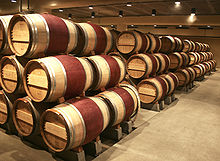
Professions
| Name | Description |
|---|---|
| Cooper | A craftsperson of wooden barrels and casks. A cooperage is a facility that produces such casks |
| Négociant | A wine merchant that purchases the product of smaller growers and/or winemakers to sell them under its own name |
| Oenologist | A wine scientist or wine chemist; a student of oenology. A winemaker may be trained as an oenologist, but often hires one as a consultant |
| Sommelier | A specialist in charge of developing a restaurant's wine list, educating the staff about wine, and assisting customers with their selections |
| Vintner, Winemaker | A wine producer; a person who makes wine |
| Viticulturist | A specialist in the science of grapevines; a manager of vineyard pruning, irrigation, and pest control |
